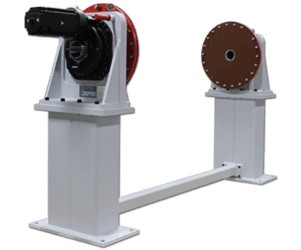Headstock / Tailstock Applications and Considerations
No Comments - Leave a Comment
Headstock and Tailstock sets are most often utilized for weld positioning and assembly. Specifically, headstock and tailstock sets hold long, heavy components between them and allow rotation of the component in order to facilitate welding or assembly of parts to the held component.
ADVANTAGES OF USING HEADSTOCKS AND TAILSTOCKS
Using headstocks / tailstocks can improve ergonomics, decreasing the risk of accidents or injuries while working on and around large heavy components.
The use of headstocks and tailstocks can increase welding productivity and weld quality by providing the proper welding angle and allowing the welder to quickly get into the right position for the next weld.
HEADSTOCK AND TAILSTOCK CONSIDERATIONS

When used as a weld positioner, headstocks and tailstocks are most often oriented horizontally, or with the axis of rotation parallel to the floor. For shorter weldments of modest weight, it’s sometimes possible to use only a headstock with the weldment clamped to the rotating bed. However, this creates an overhung load. For heavier parts, and particularly parts that are longer, the headstock may be paired with a tailstock. The tailstock picks up some of the weight of the overhung load, ensuring an accident free process and extending the life of the headstock. The headstock has the drives and controls and the tailstock freely rotates along with the headstock. For very heavy parts, rollers may also be placed under the weldment to carry some load.
Given that the durability of the headstock / tailstock system as well as safety and productivity are in play, it’s important to work with an experienced headstock / tailstock provider to ensure that the engineering factors are carefully evaluated. The right company will work with you to help you to select control and drive options as well as any customizations that you may need.
Comments
No Comments - Leave a Comment

 Translate
Translate